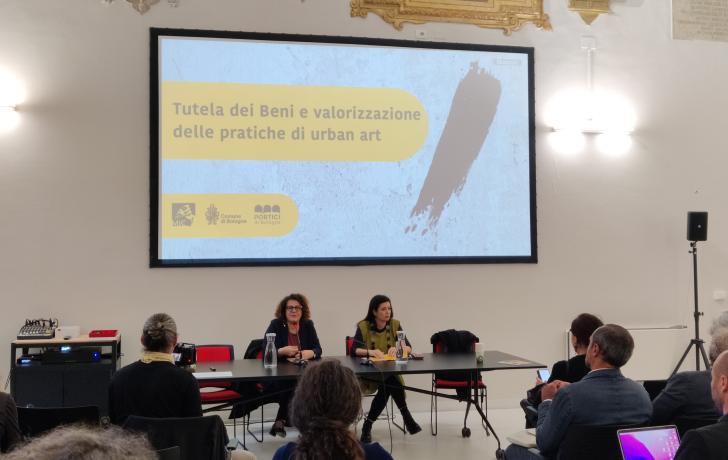TheHeritage Conservation and Urban Art Enhancement conference was held in Sala Tassinari at Palazzo d’Accursio on 27 October 2023 to review the status of the relationship between public urban heritage properties and contemporary forms of artistic expression having a high impact on the city. The World Heritage Porticoes Office and the Culture and Creativity Unit of the Municipality of Bologna drew up this initiative, which has been financed by the Italian Ministry of Culture thanks to funds that Italian Law 77/2006 allocates to the activities of Italian properties on the UNESCO World Heritage List.
The topic isn’t new, but there is an increasing need for dialogue between public administrations to raise awareness about good practices to be implemented.
The conference opened with the institutional greetings of Valentina Orioli, Councilwoman for Mobility in charge of the UNESCO Porticoes, and Elena di Gioia, Deputy of Culture. A brief introduction by Giorgia Boldrini, Director of the Culture and Creativity Unit, followed. She highlighted the topic of the day, that is, the often conflictual and contradictory relationship between Heritage, which is to be taken care of and protected, and creativity, which in the area of urban art necessarily affects the city’s cultural properties. The floor was then given to other Italian administrations considered central to discourse about the topic, to talk about what they are doing: Turin (Marco Ciari and Riccardo Lanfranco), Florence (Stefania Pancini, Sofia Bonacchi) and Naples (Fabio Landolfo and Luca Borriello), between which an overview of Bologna’s situation was presented (Lorenzo Balbi, Federica Legnani and Francesco Volta). The review was concluded by representatives of the Cheap project (Sara Manfredi and Flavia Tommasini), who for some time have been engaged in bringing themes and forms of high-impact art into public spaces, such as the billboards which often hold notices, adverts and announcements.
Specific aspects of the problem were closely examined in the afternoon. Francesca Benatti spoke on copyright and, in general, some legal implications that street art brings into play. She was followed by Michela Berzioli, whose speech tackled the technical aspects pertaining mainly to the behaviour of different materials, mainly paint and plaster.
The afternoon came to an end with Fabiola Naldi’s speech. Using many examples, she talked as a theorist, but in full possession of the facts about what makes up the street artist’s action, an anarchic moment of irony and provocation.
Participants were fully satisfied when the day ended. Rather than an irenic feeling of having everything understood and under control, what clearly emerged from the many contradictions in play is that there is a lot of work to be done. However, a channel of communication has opened up between the numerous active parties that makes it, if not easier, at least more aware.

